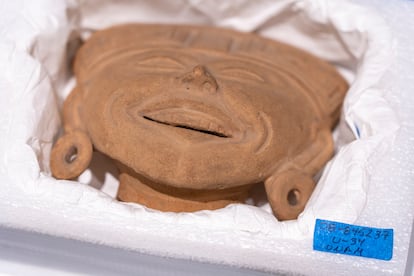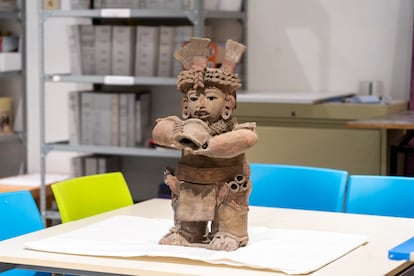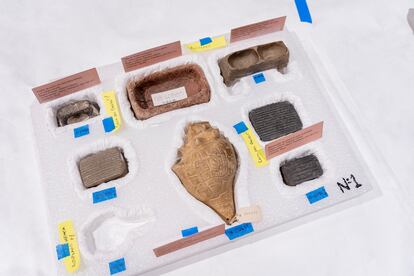Archaeologist Fernando Carrizosa and four of his colleagues carefully lift the lid of a huge packaging box before the expectant gaze of a dozen reporters. The cameras focus on the hulk built with shock-resistant materials, waiting for the treasure it protects to be discovered: a series of archaeological pieces that are part of an enormous heritage that the National Autonomous University of Mexico (UNAM) presents for the first time to the public. Carrizosa explains that the boxes have been meticulously moved from Ciudad Universitaria to the University Cultural Center of Tlatelolco, in the heart of the Mexican capital, in arduous logistical work to deposit them in what will be the great University Art Fund of the Native Peoples Mexicans (Fuapo), which as of this Tuesday brings together 12,550 pre-Hispanic pieces. “It is a milestone for the Archeology of Mexico,” says Rosa Beltrán, UNAM Culture Coordinator.
Carrizosa and his team have worked for four years—including a terrible year of the pandemic—cataloging and studying the thousands of pieces that were kept in the UNAM vaults to complete this archaeological collection, one of the largest in Mexico. The archaeologist explains that most of the pieces come from private collections, which were donated to the UNAM in the middle of the last century, so many studies still need to be done to determine if among them there are pieces that are not originals, but rather perfect imitations. “They may be a minimum,” warns the expert.


Thousands of these pre-Hispanic works were acquired by private collectors at the beginning of the 20th century, when there were no current laws that protect Mexican heritage. It was common for these types of relics to be purchased in markets, bazaars or through trade between collectors, without the authorities paying much attention to this exchange of Mexico’s historical treasure. UNAM experts have had to spend years studying the origin of the pieces, although in most cases it is difficult for them to know where and how they were extracted. One of the collections in which the origin of the works is known is that the family of Carlos Molina and Rosa María López donated to the university. Molina came across the pieces when some children were trying to sell them to a foreigner, possibly of French nationality, and warned that they were national heritage. The pieces had come to light when machines were excavating the land to build what would be the housing center of Tlatelolco, a rich archaeological zone in the capital. He then rescued about 200 pieces, which his family later donated to the university.
Carrizosa, in charge of the systematization of the UNAM archaeological collections, has explained that they will continue with scientific analyzes to determine the originality of the artifacts, which translates into subjecting them to microscopy and X-ray studies. “We analyze, for example, the composition of the ceramics, of the clay, and that can allow us not only to date the piece, but also to be able to determine where they obtained that clay to create it and thus know if the piece is authentic or not,” the archaeologist explains to this newspaper. To determine this originality, experts subject the objects to so-called “destructive tests”, that is, they take a small sample of the piece from a non-visible part and then take it to the laboratories. “Specialized experts allow us to know if the pieces comply with the manufacturing stylistic characteristics that were used at that time,” says Carrizosa. These are experts who have carefully studied the various regions of Mexico and who can determine whether a piece is from the central area, the north or the Mexican isthmus. The studies carried out to date determine that many of the pieces in the UNAM collection come from the Mayan region, Oaxaca, the Gulf Coast, and the highlands.

This collection was presented as a great event this Tuesday by the UNAM authorities, meeting at the headquarters of the Tlatelolco University Cultural Center. Rosa Beltrán highlighted that it is the first time in its history that the university brings together its archaeological collection in a single site. It was done through a complex transfer of packaging boxes, many of them so heavy that the use of hydraulic systems was necessary. The boxes were protected with special materials that resist impacts and are also insulating. The wineries of the cultural center have been adapted with refrigeration systems and lighting control to guarantee the preservation of the objects. “They are unpublished pieces, which have never been exhibited,” emphasizes Beltrán.
Some of the objects date back to 1,500 BC and others are between 1,300 and 1,500 AD. These are ceramic, shell and metal objects; Among the collection are vessels, masks, incendiaries, miniatures, sculptures, everyday artifacts, and various types of utensils. There are so many pieces that it is impossible to show them all in one exhibition, so the authorities have decided to rotate their presentation: every October there will be a change of objects in the rooms of the cultural center, as determined by curatorial experts. The first exhibition will begin this July. “It has been a huge job preparing this collection,” remarks archaeologist Lucía Sánchez, coordinator of the Xaltilolli Interpretation Center, also in Tlatelolco. “We will continue the studies and lines of research, because we want to recover its history,” says the expert. Sánchez and Carrizosa are excited about the colossal work that the immense collection poses for them. On Tuesday they were happy in front of the cameras as they removed the vessels that preserve Mexico’s ancient history from their protective packaging.
Sign up for the EL PAÍS México newsletter for free and to WhatsApp channel and receive all the key information on current events in this country.
Subscribe to continue reading
Read without limits
_

